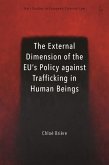Chloé Brière
The External Dimension of the EU's Policy against Trafficking in Human Beings (eBook, ePUB)
35,95 €
35,95 €
inkl. MwSt.
Sofort per Download lieferbar

18 °P sammeln
35,95 €
Als Download kaufen

35,95 €
inkl. MwSt.
Sofort per Download lieferbar

18 °P sammeln
Jetzt verschenken
Alle Infos zum eBook verschenken
35,95 €
inkl. MwSt.
Sofort per Download lieferbar
Alle Infos zum eBook verschenken

18 °P sammeln
Chloé Brière
The External Dimension of the EU's Policy against Trafficking in Human Beings (eBook, ePUB)
- Format: ePub
- Merkliste
- Auf die Merkliste
- Bewerten Bewerten
- Teilen
- Produkt teilen
- Produkterinnerung
- Produkterinnerung

Bitte loggen Sie sich zunächst in Ihr Kundenkonto ein oder registrieren Sie sich bei
bücher.de, um das eBook-Abo tolino select nutzen zu können.
Hier können Sie sich einloggen
Hier können Sie sich einloggen
Sie sind bereits eingeloggt. Klicken Sie auf 2. tolino select Abo, um fortzufahren.

Bitte loggen Sie sich zunächst in Ihr Kundenkonto ein oder registrieren Sie sich bei bücher.de, um das eBook-Abo tolino select nutzen zu können.
This book explores the external dimension of the ambitious EU policy on human trafficking. Through this policy the EU institutions and Member States promote the eradication of human trafficking and support, to that end, cooperation with their partners, being third States or international organisations. Analysing the unilateral and multilateral mechanisms the EU uses to achieve these aims, the book questions whether the EU's external response to human trafficking addresses it in all its dimensions, and whether it does so in a coherent way. As a case study, the book explores the cooperation of…mehr
- Geräte: eReader
- mit Kopierschutz
- eBook Hilfe
- Größe: 0.45MB
Andere Kunden interessierten sich auch für
![The External Dimension of the EU's Policy against Trafficking in Human Beings (eBook, PDF) The External Dimension of the EU's Policy against Trafficking in Human Beings (eBook, PDF)]() Chloé BrièreThe External Dimension of the EU's Policy against Trafficking in Human Beings (eBook, PDF)35,95 €
Chloé BrièreThe External Dimension of the EU's Policy against Trafficking in Human Beings (eBook, PDF)35,95 €![EU External Relations and the Power of Law (eBook, ePUB) EU External Relations and the Power of Law (eBook, ePUB)]() EU External Relations and the Power of Law (eBook, ePUB)73,95 €
EU External Relations and the Power of Law (eBook, ePUB)73,95 €![Constitutional Law of the EU's Common Foreign and Security Policy (eBook, ePUB) Constitutional Law of the EU's Common Foreign and Security Policy (eBook, ePUB)]() Graham ButlerConstitutional Law of the EU's Common Foreign and Security Policy (eBook, ePUB)36,95 €
Graham ButlerConstitutional Law of the EU's Common Foreign and Security Policy (eBook, ePUB)36,95 €![EU External Relations Law (eBook, ePUB) EU External Relations Law (eBook, ePUB)]() EU External Relations Law (eBook, ePUB)99,95 €
EU External Relations Law (eBook, ePUB)99,95 €![EU External Relations Law (eBook, ePUB) EU External Relations Law (eBook, ePUB)]() Ramses A WesselEU External Relations Law (eBook, ePUB)49,95 €
Ramses A WesselEU External Relations Law (eBook, ePUB)49,95 €![The Constitutional Dimension of European Criminal Law (eBook, ePUB) The Constitutional Dimension of European Criminal Law (eBook, ePUB)]() Ester Herlin-KarnellThe Constitutional Dimension of European Criminal Law (eBook, ePUB)78,95 €
Ester Herlin-KarnellThe Constitutional Dimension of European Criminal Law (eBook, ePUB)78,95 €![The Development of Child Protection Law and Policy (eBook, ePUB) The Development of Child Protection Law and Policy (eBook, ePUB)]() Kieran WalshThe Development of Child Protection Law and Policy (eBook, ePUB)41,95 €
Kieran WalshThe Development of Child Protection Law and Policy (eBook, ePUB)41,95 €-
-
-
This book explores the external dimension of the ambitious EU policy on human trafficking. Through this policy the EU institutions and Member States promote the eradication of human trafficking and support, to that end, cooperation with their partners, being third States or international organisations. Analysing the unilateral and multilateral mechanisms the EU uses to achieve these aims, the book questions whether the EU's external response to human trafficking addresses it in all its dimensions, and whether it does so in a coherent way. As a case study, the book explores the cooperation of the EU with countries of the Western Balkans, which constitutes a specific unilateral mechanism. The analysis of the multilateral mechanisms covers the cooperation of the EU with key international and regional organisations combating human trafficking, including but not limited to the Council of Europe or the United Nations Office on Drugs and Crime. The book also examines the impact of the evolution of migration flows and the increasing reliance of military tools on the EU's response to human trafficking.
Produktdetails
- Produktdetails
- Verlag: Bloomsbury eBooks UK
- Seitenzahl: 328
- Erscheinungstermin: 8. April 2021
- Englisch
- ISBN-13: 9781509932832
- Artikelnr.: 61341978
- Verlag: Bloomsbury eBooks UK
- Seitenzahl: 328
- Erscheinungstermin: 8. April 2021
- Englisch
- ISBN-13: 9781509932832
- Artikelnr.: 61341978
- Herstellerkennzeichnung Die Herstellerinformationen sind derzeit nicht verfügbar.
Chloé Brière is a Post-doctoral Research Fellow funded by the Belgian National Research Fund (FNRS) and a professor of EU law at the Centre for European Law of the Université libre de Bruxelles.
Introduction: Setting the Scene
I. Trafficking in Human Beings: A Global Challenge Impacting the EU
A. Trafficking in Human Beings as a Global Challenge
B. Trafficking in Human Beings as a Challenge for the EU
II. Definition of Key Concepts
A. Definition of Trafficking in Human Beings
B. The EU's Approach to Combating Trafficking in Human Beings
C. The External Dimension of the EU's Policy against Trafficking
III. How to Analyse the External Dimension of the EU's Policy against
Trafficking
IV. Structure of the Book
1. Framing the EU's Policy and its External Competences
I. Introduction
II. The Identification of the Core Components of the EU's Policy
A. What is the Acquis? Presentation of a Concept
B. What is the Acquis in the Field of the Prevention and Fight against
Trafficking in Human Beings?
C. Conclusions
III. External Competences at the Disposal of the EU
A. Specificities of the Union's External Competences Linked to the Area of
Freedom, Security and Justice
B. The Union's Relevant Express Competences
C. The Union's Relevant Implied Competences
D. Constitutional Principles Guiding the EU's External Counter-Trafficking
Activities
E. Conclusions
IV. Conclusions on the EU's Policy against Trafficking in Human Beings and
its External Competences
2. Unilateral Promotion of the EU's Policy: Case Study of the Western
Balkans
I. Selection of the Case Study
A. The Desire of the EU to Establish Close Cooperation in the Fight against
Crime
B. The SAP with the Western Balkans as the Selected Case Study
II. Promotion of the Fight against Trafficking Via Soft Law
III. Promotion of the Fight against Trafficking Via the Conclusion of
Agreements
A. Association Agreements
B. Agreements with EU JHA Agencies
C. Agreements Concluded by the EU Member States
D. Conclusion
IV. The Support of Regional Cooperation
A. Regional Initiatives Promoting Police Cooperation
B. Regional Initiatives Promoting Judicial Cooperation
C. Regional Cooperation Among National Anti-Trafficking Coordinators
D. Regional Cooperation as a Preparation for Accession
V. Conclusions
3. Multilateral Promotion of the EU's Policy
I. Introduction
II. The EU's Commitment to Multilateralism
III. Institutional Multilateralism: Identification of Relevant Actors
A. Traditional Multilateral Actors: International and Regional
Intergovernmental Organisations
B. Non-Traditional Multilateral Actors: Private Actors
C. A Tapestry Incomplete without Mentioning States
D. Conclusion
IV. Normative Interactions: The EU as a Norm-Taker or a Norm-Setter?
A. Interactions Leading to a Common Approach and Objectives
B. Consensus About the Objectives to be Pursued
C. Interactions Leading to Consistent Standards
D. Conclusion
V. Multilateralism in Action: Coordination Mechanisms to Avoid Duplication
of Efforts
A. Internal Coordination Mechanisms in Large Organisations
B. Bilateral and Multilateral Mechanisms Among Partners
C. Importance of the Coordination and Cooperation Efforts
VI. Conclusion
4. Limits of the EU's Actions and Future Avenues for Research
I. Addressing Trafficking in the Framework of a Renewed EU Migration Policy
II. Militarisation of the Response to Trafficking in Human Beings
A. The Mobilisation of CFSP Competences
B. Trafficking in Armed Conflicts
III. Conclusion
A. Is the EU's Response Coherent?
B. Is the EU's Response Comprehensive?
C. The Accountability Gaps
I. Trafficking in Human Beings: A Global Challenge Impacting the EU
A. Trafficking in Human Beings as a Global Challenge
B. Trafficking in Human Beings as a Challenge for the EU
II. Definition of Key Concepts
A. Definition of Trafficking in Human Beings
B. The EU's Approach to Combating Trafficking in Human Beings
C. The External Dimension of the EU's Policy against Trafficking
III. How to Analyse the External Dimension of the EU's Policy against
Trafficking
IV. Structure of the Book
1. Framing the EU's Policy and its External Competences
I. Introduction
II. The Identification of the Core Components of the EU's Policy
A. What is the Acquis? Presentation of a Concept
B. What is the Acquis in the Field of the Prevention and Fight against
Trafficking in Human Beings?
C. Conclusions
III. External Competences at the Disposal of the EU
A. Specificities of the Union's External Competences Linked to the Area of
Freedom, Security and Justice
B. The Union's Relevant Express Competences
C. The Union's Relevant Implied Competences
D. Constitutional Principles Guiding the EU's External Counter-Trafficking
Activities
E. Conclusions
IV. Conclusions on the EU's Policy against Trafficking in Human Beings and
its External Competences
2. Unilateral Promotion of the EU's Policy: Case Study of the Western
Balkans
I. Selection of the Case Study
A. The Desire of the EU to Establish Close Cooperation in the Fight against
Crime
B. The SAP with the Western Balkans as the Selected Case Study
II. Promotion of the Fight against Trafficking Via Soft Law
III. Promotion of the Fight against Trafficking Via the Conclusion of
Agreements
A. Association Agreements
B. Agreements with EU JHA Agencies
C. Agreements Concluded by the EU Member States
D. Conclusion
IV. The Support of Regional Cooperation
A. Regional Initiatives Promoting Police Cooperation
B. Regional Initiatives Promoting Judicial Cooperation
C. Regional Cooperation Among National Anti-Trafficking Coordinators
D. Regional Cooperation as a Preparation for Accession
V. Conclusions
3. Multilateral Promotion of the EU's Policy
I. Introduction
II. The EU's Commitment to Multilateralism
III. Institutional Multilateralism: Identification of Relevant Actors
A. Traditional Multilateral Actors: International and Regional
Intergovernmental Organisations
B. Non-Traditional Multilateral Actors: Private Actors
C. A Tapestry Incomplete without Mentioning States
D. Conclusion
IV. Normative Interactions: The EU as a Norm-Taker or a Norm-Setter?
A. Interactions Leading to a Common Approach and Objectives
B. Consensus About the Objectives to be Pursued
C. Interactions Leading to Consistent Standards
D. Conclusion
V. Multilateralism in Action: Coordination Mechanisms to Avoid Duplication
of Efforts
A. Internal Coordination Mechanisms in Large Organisations
B. Bilateral and Multilateral Mechanisms Among Partners
C. Importance of the Coordination and Cooperation Efforts
VI. Conclusion
4. Limits of the EU's Actions and Future Avenues for Research
I. Addressing Trafficking in the Framework of a Renewed EU Migration Policy
II. Militarisation of the Response to Trafficking in Human Beings
A. The Mobilisation of CFSP Competences
B. Trafficking in Armed Conflicts
III. Conclusion
A. Is the EU's Response Coherent?
B. Is the EU's Response Comprehensive?
C. The Accountability Gaps
Introduction: Setting the Scene
I. Trafficking in Human Beings: A Global Challenge Impacting the EU
A. Trafficking in Human Beings as a Global Challenge
B. Trafficking in Human Beings as a Challenge for the EU
II. Definition of Key Concepts
A. Definition of Trafficking in Human Beings
B. The EU's Approach to Combating Trafficking in Human Beings
C. The External Dimension of the EU's Policy against Trafficking
III. How to Analyse the External Dimension of the EU's Policy against
Trafficking
IV. Structure of the Book
1. Framing the EU's Policy and its External Competences
I. Introduction
II. The Identification of the Core Components of the EU's Policy
A. What is the Acquis? Presentation of a Concept
B. What is the Acquis in the Field of the Prevention and Fight against
Trafficking in Human Beings?
C. Conclusions
III. External Competences at the Disposal of the EU
A. Specificities of the Union's External Competences Linked to the Area of
Freedom, Security and Justice
B. The Union's Relevant Express Competences
C. The Union's Relevant Implied Competences
D. Constitutional Principles Guiding the EU's External Counter-Trafficking
Activities
E. Conclusions
IV. Conclusions on the EU's Policy against Trafficking in Human Beings and
its External Competences
2. Unilateral Promotion of the EU's Policy: Case Study of the Western
Balkans
I. Selection of the Case Study
A. The Desire of the EU to Establish Close Cooperation in the Fight against
Crime
B. The SAP with the Western Balkans as the Selected Case Study
II. Promotion of the Fight against Trafficking Via Soft Law
III. Promotion of the Fight against Trafficking Via the Conclusion of
Agreements
A. Association Agreements
B. Agreements with EU JHA Agencies
C. Agreements Concluded by the EU Member States
D. Conclusion
IV. The Support of Regional Cooperation
A. Regional Initiatives Promoting Police Cooperation
B. Regional Initiatives Promoting Judicial Cooperation
C. Regional Cooperation Among National Anti-Trafficking Coordinators
D. Regional Cooperation as a Preparation for Accession
V. Conclusions
3. Multilateral Promotion of the EU's Policy
I. Introduction
II. The EU's Commitment to Multilateralism
III. Institutional Multilateralism: Identification of Relevant Actors
A. Traditional Multilateral Actors: International and Regional
Intergovernmental Organisations
B. Non-Traditional Multilateral Actors: Private Actors
C. A Tapestry Incomplete without Mentioning States
D. Conclusion
IV. Normative Interactions: The EU as a Norm-Taker or a Norm-Setter?
A. Interactions Leading to a Common Approach and Objectives
B. Consensus About the Objectives to be Pursued
C. Interactions Leading to Consistent Standards
D. Conclusion
V. Multilateralism in Action: Coordination Mechanisms to Avoid Duplication
of Efforts
A. Internal Coordination Mechanisms in Large Organisations
B. Bilateral and Multilateral Mechanisms Among Partners
C. Importance of the Coordination and Cooperation Efforts
VI. Conclusion
4. Limits of the EU's Actions and Future Avenues for Research
I. Addressing Trafficking in the Framework of a Renewed EU Migration Policy
II. Militarisation of the Response to Trafficking in Human Beings
A. The Mobilisation of CFSP Competences
B. Trafficking in Armed Conflicts
III. Conclusion
A. Is the EU's Response Coherent?
B. Is the EU's Response Comprehensive?
C. The Accountability Gaps
I. Trafficking in Human Beings: A Global Challenge Impacting the EU
A. Trafficking in Human Beings as a Global Challenge
B. Trafficking in Human Beings as a Challenge for the EU
II. Definition of Key Concepts
A. Definition of Trafficking in Human Beings
B. The EU's Approach to Combating Trafficking in Human Beings
C. The External Dimension of the EU's Policy against Trafficking
III. How to Analyse the External Dimension of the EU's Policy against
Trafficking
IV. Structure of the Book
1. Framing the EU's Policy and its External Competences
I. Introduction
II. The Identification of the Core Components of the EU's Policy
A. What is the Acquis? Presentation of a Concept
B. What is the Acquis in the Field of the Prevention and Fight against
Trafficking in Human Beings?
C. Conclusions
III. External Competences at the Disposal of the EU
A. Specificities of the Union's External Competences Linked to the Area of
Freedom, Security and Justice
B. The Union's Relevant Express Competences
C. The Union's Relevant Implied Competences
D. Constitutional Principles Guiding the EU's External Counter-Trafficking
Activities
E. Conclusions
IV. Conclusions on the EU's Policy against Trafficking in Human Beings and
its External Competences
2. Unilateral Promotion of the EU's Policy: Case Study of the Western
Balkans
I. Selection of the Case Study
A. The Desire of the EU to Establish Close Cooperation in the Fight against
Crime
B. The SAP with the Western Balkans as the Selected Case Study
II. Promotion of the Fight against Trafficking Via Soft Law
III. Promotion of the Fight against Trafficking Via the Conclusion of
Agreements
A. Association Agreements
B. Agreements with EU JHA Agencies
C. Agreements Concluded by the EU Member States
D. Conclusion
IV. The Support of Regional Cooperation
A. Regional Initiatives Promoting Police Cooperation
B. Regional Initiatives Promoting Judicial Cooperation
C. Regional Cooperation Among National Anti-Trafficking Coordinators
D. Regional Cooperation as a Preparation for Accession
V. Conclusions
3. Multilateral Promotion of the EU's Policy
I. Introduction
II. The EU's Commitment to Multilateralism
III. Institutional Multilateralism: Identification of Relevant Actors
A. Traditional Multilateral Actors: International and Regional
Intergovernmental Organisations
B. Non-Traditional Multilateral Actors: Private Actors
C. A Tapestry Incomplete without Mentioning States
D. Conclusion
IV. Normative Interactions: The EU as a Norm-Taker or a Norm-Setter?
A. Interactions Leading to a Common Approach and Objectives
B. Consensus About the Objectives to be Pursued
C. Interactions Leading to Consistent Standards
D. Conclusion
V. Multilateralism in Action: Coordination Mechanisms to Avoid Duplication
of Efforts
A. Internal Coordination Mechanisms in Large Organisations
B. Bilateral and Multilateral Mechanisms Among Partners
C. Importance of the Coordination and Cooperation Efforts
VI. Conclusion
4. Limits of the EU's Actions and Future Avenues for Research
I. Addressing Trafficking in the Framework of a Renewed EU Migration Policy
II. Militarisation of the Response to Trafficking in Human Beings
A. The Mobilisation of CFSP Competences
B. Trafficking in Armed Conflicts
III. Conclusion
A. Is the EU's Response Coherent?
B. Is the EU's Response Comprehensive?
C. The Accountability Gaps







